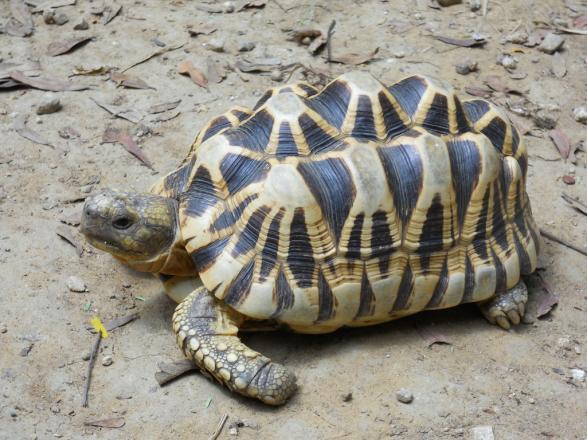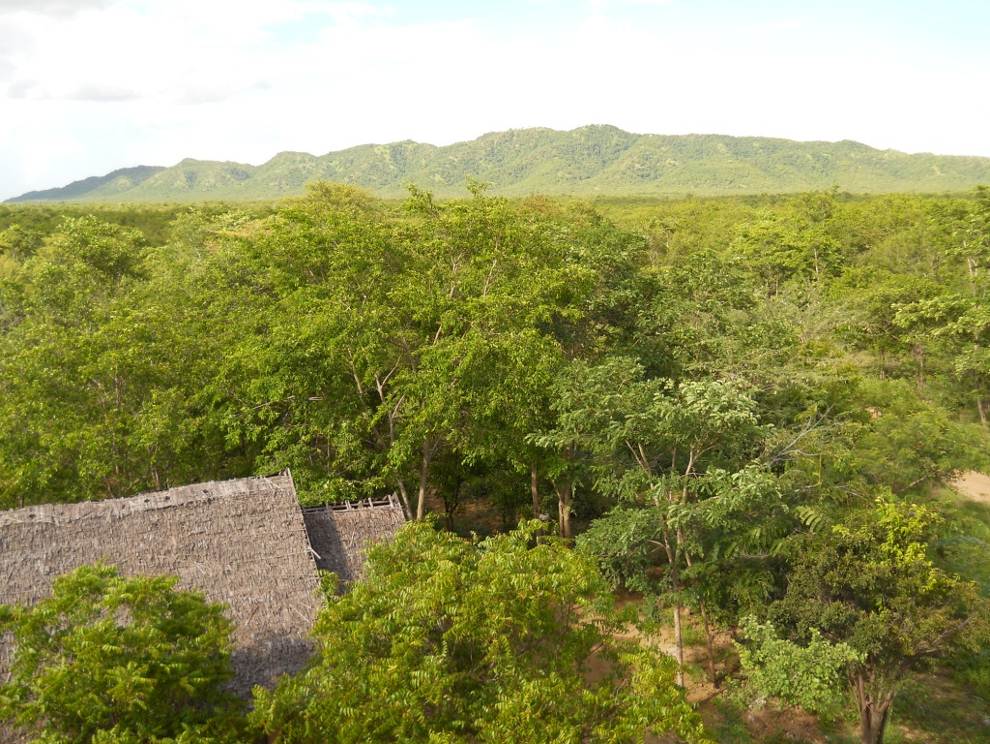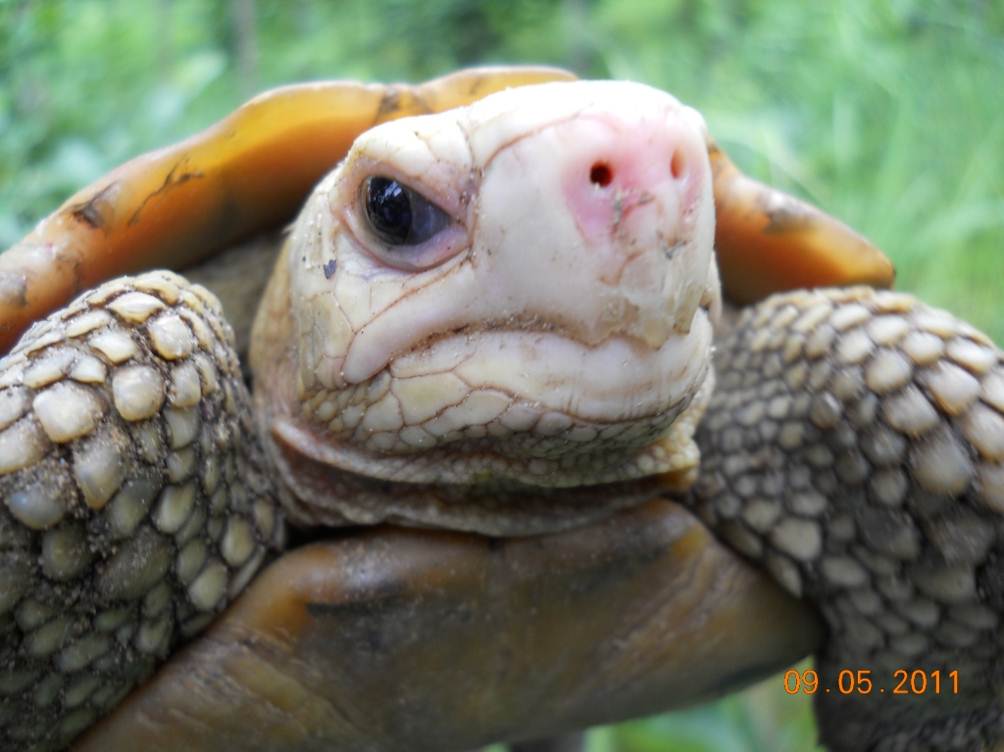Assessing reintroduction sites for Burmese star tortoises
by Kalyar Platt, PhD 
 Recognizing that future conservation efforts for Burmese star tortoises (Geochelone platynota) hinge on developing successful captive breeding programs to supply tortoises for eventual reintroduction into protected habitats, assurance colonies were established at Yadanabon Zoological Gardens (Mandalay), and at the Minzontaung, Lawkanandar, and Shwe Settaw wildlife sanctuaries. To date, these programs have enjoyed considerable success and large numbers of hatchlings are being produced each year. Consequently, these facilities will soon reach maximum capacity and there is an urgent need to initiate carefully planned and monitored reintroductions of G. platynota into suitable habitat in protected areas of Myanmar. To this end, we revisited two previously identified sites (Shwe Settaw and Minzontaung wildlife sanctuaries) known to harbor populations of G. platynota, and evaluated the potential of each area for future reintroductions of captive bred tortoises.
Recognizing that future conservation efforts for Burmese star tortoises (Geochelone platynota) hinge on developing successful captive breeding programs to supply tortoises for eventual reintroduction into protected habitats, assurance colonies were established at Yadanabon Zoological Gardens (Mandalay), and at the Minzontaung, Lawkanandar, and Shwe Settaw wildlife sanctuaries. To date, these programs have enjoyed considerable success and large numbers of hatchlings are being produced each year. Consequently, these facilities will soon reach maximum capacity and there is an urgent need to initiate carefully planned and monitored reintroductions of G. platynota into suitable habitat in protected areas of Myanmar. To this end, we revisited two previously identified sites (Shwe Settaw and Minzontaung wildlife sanctuaries) known to harbor populations of G. platynota, and evaluated the potential of each area for future reintroductions of captive bred tortoises.
 Turtle Survival Alliance and Wildlife Conservation Society conducted fieldwork in Shwe Settaw and Minzontaung wildlife sanctuaries (SSWS and MWS) in September 2011. SSWS is composed of four separate management units comprising 114,726 acres. A Buffer Zone consisting of 64,391 acres surrounds the wildlife sanctuary. Low hills and deep ravines characterize much of SSWS. The vegetation of SSWS is characterized by Indaing and Than dahat forest types. Minzontaung Wildlife Sanctuary was established in 1998-99 for the protection of Eld’s deer and comprises 2260 ha. The topography of MWS is dominated by Minzon Taung (=Mountain), an isolated hill mass that rises to a maximum elevation of 398 m. The vegetation of MWS has been variously described as Thorn Forest, Thorn Scrub, and Euphorbia Scrub.
Turtle Survival Alliance and Wildlife Conservation Society conducted fieldwork in Shwe Settaw and Minzontaung wildlife sanctuaries (SSWS and MWS) in September 2011. SSWS is composed of four separate management units comprising 114,726 acres. A Buffer Zone consisting of 64,391 acres surrounds the wildlife sanctuary. Low hills and deep ravines characterize much of SSWS. The vegetation of SSWS is characterized by Indaing and Than dahat forest types. Minzontaung Wildlife Sanctuary was established in 1998-99 for the protection of Eld’s deer and comprises 2260 ha. The topography of MWS is dominated by Minzon Taung (=Mountain), an isolated hill mass that rises to a maximum elevation of 398 m. The vegetation of MWS has been variously described as Thorn Forest, Thorn Scrub, and Euphorbia Scrub.
Our specific objectives when evaluating each wildlife sanctuary were to:
a. Determine if extant star tortoise populations remain in the sanctuary.
b. Assess the suitability of available habitat for released tortoises.
c. Identify human impacts (grazing, fuelwood cutting, etc.) on habitat and determine if these impacts pose a potential threat to reintroduced tortoises.
d. Evaluate access by local villagers and determine if sites (or remote locations at each site) can feasibly be protected from incursions by potential poachers.
e. Evaluate the level of security afforded by Forest Department personnel to determine if adequate post-release protection of reintroduced tortoises will be possible.
f. Develop site-specific plans for reintroducing star tortoises to each sanctuary if deemed biologically and socially feasible.
 To determine the conservation status of tortoises in Shwe Settaw Wildlife Sanctuary we used local hunters and their dogs to search for tortoises. Local hunting dogs were unavailable in Minzontaung Wildlife Sanctuary. During the survey we also conducted open-ended interviews of farmers, villagers, and other knowledgeable individuals regarding the local occurrence of tortoises and levels of exploitation. We consulted local Forest Department personnel regarding potential sites in each wildlife sanctuary where reintroduction of tortoises might prove feasible. We then visited each site and evaluated it on the basis of habitat suitability, accessibility by sanctuary personnel and villagers, existing infrastructure, particularly with regards to security (e.g., basecamps, guard posts, etc.), and human impacts (shifting cultivation, tree-felling, livestock grazing, etc.) in the immediate area.
To determine the conservation status of tortoises in Shwe Settaw Wildlife Sanctuary we used local hunters and their dogs to search for tortoises. Local hunting dogs were unavailable in Minzontaung Wildlife Sanctuary. During the survey we also conducted open-ended interviews of farmers, villagers, and other knowledgeable individuals regarding the local occurrence of tortoises and levels of exploitation. We consulted local Forest Department personnel regarding potential sites in each wildlife sanctuary where reintroduction of tortoises might prove feasible. We then visited each site and evaluated it on the basis of habitat suitability, accessibility by sanctuary personnel and villagers, existing infrastructure, particularly with regards to security (e.g., basecamps, guard posts, etc.), and human impacts (shifting cultivation, tree-felling, livestock grazing, etc.) in the immediate area.
We encountered no star tortoises during 174 man-hours and 54 dog-hours of search effort in SSWS, contrasting markedly with our earlier survey in 1999. Similarly, interviews of local villagers also suggest G. platynota is extremely rare in the sanctuary. For example, traders have stopped making periodic visits because few if any, tortoises are available to buy, and villagers no longer consider it economically worthwhile to devote time and effort to search for star tortoises owing to their rarity. Regardless, any star tortoise opportunistically encountered in the forest is invariably collected and sold. Although scattered individuals persist in SSWS, these remaining tortoises cannot be considered a biologically viable population. We therefore conclude that Geochelone platynota is most likely “ecologically” extinct in SSWS.
 The conservation status of G. platynota in MWS is difficult to reliably assess. We found no wild tortoises during our reconnaissance, although this result is not unexpected given the near-impenetrable thorn scrub vegetation characteristic of the sanctuary, the cryptic habits of star tortoises, and the fact that hunting dogs were not used in our survey. Most tellingly, an intensive 10 day survey in 2008 found only a single star tortoise. This is apparently the only verified occurrence of G. platynota in the sanctuary since 2004. However, local villagers assert that star tortoises are present in the sanctuary. A high degree of protection appears to be afforded to tortoises (both G. platynota and Indotestudo elongata) in MWS by the local practice of Nat worship. In the area surrounding MWS, a Nat known as the “White Horse Rider” is believed to dwell in Minzon Taung and act as the guardian of the mountain. Villagers who disregard proscriptions against disturbing tortoises are apt to suffer divine retribution.
The conservation status of G. platynota in MWS is difficult to reliably assess. We found no wild tortoises during our reconnaissance, although this result is not unexpected given the near-impenetrable thorn scrub vegetation characteristic of the sanctuary, the cryptic habits of star tortoises, and the fact that hunting dogs were not used in our survey. Most tellingly, an intensive 10 day survey in 2008 found only a single star tortoise. This is apparently the only verified occurrence of G. platynota in the sanctuary since 2004. However, local villagers assert that star tortoises are present in the sanctuary. A high degree of protection appears to be afforded to tortoises (both G. platynota and Indotestudo elongata) in MWS by the local practice of Nat worship. In the area surrounding MWS, a Nat known as the “White Horse Rider” is believed to dwell in Minzon Taung and act as the guardian of the mountain. Villagers who disregard proscriptions against disturbing tortoises are apt to suffer divine retribution.
We evaluated a total of three potential reintroduction sites within the Shwe Settaw Wildlife Sanctuary. Because of its relatively remote location with respect to existing roads and trails, absence of human disturbance, and excellent Indaing habitat, we regard one site in particular as a superior option to release star tortoises in SSWS.
We conducted pedestrian surveys throughout MWS to inspect tortoise habitat and identify potential release sites. Most of the sanctuary appears to constitute suitable habitat for G. platynota. Because the western sector of the sanctuary contains extensive stands of dense, second-growth vegetation with minimal evidence of human activity, the area is readily accessible from MWS HQ, and this is where most star tortoises have been found during previous surveys, we recommend establishing a release site in dense forest and scrub to the north-northwest of the sanctuary HQ and south-southeast of Minzon Taung.
Our recent field assessment suggests that reintroducing star tortoises is feasible at selected sites in both Shwe Settaw and Minzontaung wildlife sanctuaries. Of the two sanctuaries, a reintroduction project at MWS probably has the greatest likelihood of success owing to locally entrenched Nat worshiping practices.
As a part of this assessment the team also developed a reintroduction protocol that includes a detailed plan for a soft release that gives the tortoises ample time to learn to forage for natural foods and promote site fidelity. In addition, the team has outlined recommendations regarding security, protection, tracking tortoises post-release and conducting community education and outreach, all of which will increase the chances of survival for the tortoises after they are reintroduced to their native habitat.
This project was made possible through the generosity of the Turtle Conservation Fund.
